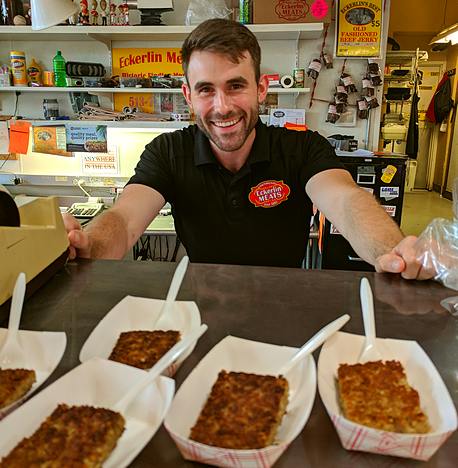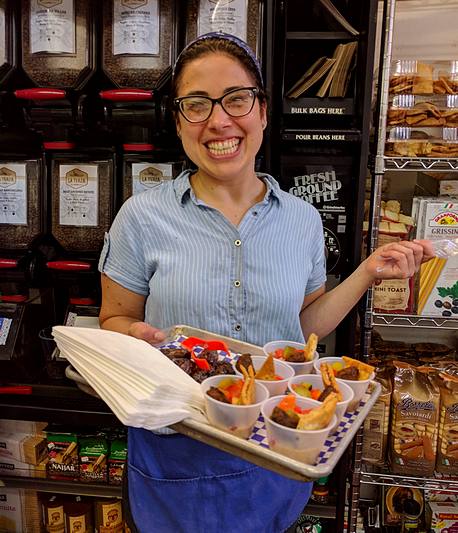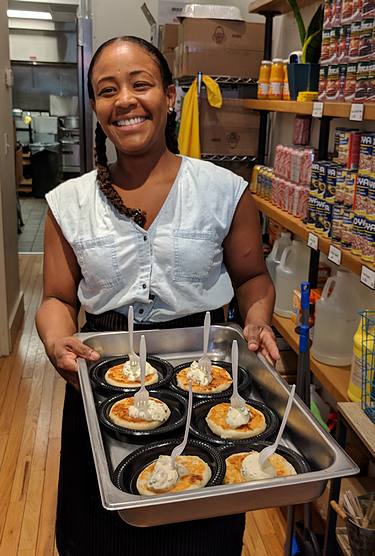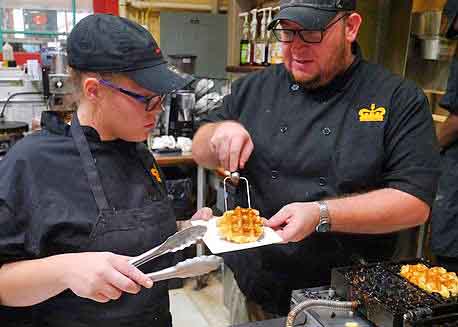 We met a true kindred spirit when we signed up for a Findlay Market Tour led by Barb Cooper (90 minutes, $30). She and her husband used to operate a fresh produce and specialty shop at the market. In 2012, she founded Cincinnati Food Tours (cincinnatifoodtours.com) to show visitors the ins and outs of the market. Her company has expanded to offer nine different tours, but the Findlay Market tour is the original.
We met a true kindred spirit when we signed up for a Findlay Market Tour led by Barb Cooper (90 minutes, $30). She and her husband used to operate a fresh produce and specialty shop at the market. In 2012, she founded Cincinnati Food Tours (cincinnatifoodtours.com) to show visitors the ins and outs of the market. Her company has expanded to offer nine different tours, but the Findlay Market tour is the original.
Just as Findlay Market, completed in 1852, is itself an original. It’s the oldest continuously operating public market in Ohio. Like all such markets in the pre-supermarket days, it provided fresh produce, meat, and fish to city residents, including the large German population of its Over-the-Rhine neighborhood (OTR).
“In the last 10 to 12 years, vendors have added more prepared foods to the fresh produce,” Cooper told us. “The market has helped introduce people to many different cultures.” Cooper then proceeded to introduce us to some of the market’s oldest and newest merchants.
Getting to the meat of the matter
 We started at Eckerlin Meats (eckerlinmeats.com). The sixth-generation butcher shop has been at the market since the very beginning. The shop offers all the fresh-cut meats and sausages that you can imagine, but is also the go-to place for a real Cincinnati food specialty.
We started at Eckerlin Meats (eckerlinmeats.com). The sixth-generation butcher shop has been at the market since the very beginning. The shop offers all the fresh-cut meats and sausages that you can imagine, but is also the go-to place for a real Cincinnati food specialty.
“We’re known for our goetta,” counterman Ryan Lohbeck said as he handed out samples. The sausage-like goetta is made with pork shoulder, beef chuck, steel-cut (pinhead) oats, and a proprietary list of seasonings. Slow-cooked for four to five hours, it solidifies enough to be cut into squares. It’s similar to eastern Pennsylvania scrapple, except that the pinhead oats give it more texture than the cornmeal and buckwheat in scrapple. Lightly greasy and mildly spicy, it’s a tasty breakfast side.
“People used to make it at home,” Lohbeck said. “But most people don’t anymore. They say ours is the closest to homemade.”
The butcher shop sells 2,000 pounds of goetta a week, often to be served as breakfast sausage. “Just throw a little butter in a pan on medium-high heat to cook it,” Lohbeck advised. Or purchase one of Eckerlin’s egg and cheese breakfast sandwiches.
Dean’s puts the spices into life
 Compared to Eckerlin, Dean’s Mediterranean (mediterranean-imports.com) is a relative newcomer. Dean Zaidan opened the market 30 years ago to bring the food products of his native Lebanon to Cincinnati cooks and diners. “When my dad came here in the 1970s, it was hard to find things like hummus and pita bread,” Kate Zaidan said.
Compared to Eckerlin, Dean’s Mediterranean (mediterranean-imports.com) is a relative newcomer. Dean Zaidan opened the market 30 years ago to bring the food products of his native Lebanon to Cincinnati cooks and diners. “When my dad came here in the 1970s, it was hard to find things like hummus and pita bread,” Kate Zaidan said.
Kate now owns the shop, which has been based in Findlay Market for the last 15 years. She greeted us with a sampler of Mediterranean flavors: falafel, spicy hummus and garlic, and oregano pita chips.
“The ethos of Mediterranean cuisine is to start with great ingredients,” Kate told us. Her shop is packed floor to ceiling with just those goods – from nuts and spices to olive oils, grains, and dried fruits. Kate also has a menu of wraps and flatbreads that are perfect for a healthy lunch. The hummus wrap with minty slaw and vegetables is her grandmother’s recipe.
“My grandmother lived with us for a number of years,” Kate recalled with a smile. “We love to eat and talk about food.”
Colombian street food comes to Cincinnati
 On the opposite side of the market, Isis Arrietta-Dennis is a Findlay Kitchen success story. Originally from Colombia, she opened The Arepa Place (arepaplace.com) in October 2018 after working out of Findlay Kitchen and a market pop-up tent for two years. She’s introducing market-goers to Colombian street food—most notably arepas, a kind of corn pancake popular in both Colombia and Venezuela.
On the opposite side of the market, Isis Arrietta-Dennis is a Findlay Kitchen success story. Originally from Colombia, she opened The Arepa Place (arepaplace.com) in October 2018 after working out of Findlay Kitchen and a market pop-up tent for two years. She’s introducing market-goers to Colombian street food—most notably arepas, a kind of corn pancake popular in both Colombia and Venezuela.
“My mom and I are the cooks,” Isis told us as she described a labor-intensive process of boiling and grinding corn to make the dough for the grilled patties. The arepas can be split and stuffed with beef, chicken, cheese, black beans or fried plantains. Isis and her mother also mix mozzarella cheese into some of the arepa dough before grilling.
“It’s our version of grilled cheese,” she told us as she handed a plate to everyone in our group. “We serve it with salsa blanca flavored with garlic, cilantro, and green onion.”
It had the same satisfying cheesiness of a grilled sandwich, but with a distinct Latin accent.
No one waffles about this treat
 Guide Barb Cooper clearly knows how to please her tour groups. “We can’t leave the market without having something sweet,” she announced. Soon we were back inside the main building watching a couple of cooks turn out big, beautiful waffles on a cast iron waffle maker at Taste of Belgium (authenticwaffle.com).
Guide Barb Cooper clearly knows how to please her tour groups. “We can’t leave the market without having something sweet,” she announced. Soon we were back inside the main building watching a couple of cooks turn out big, beautiful waffles on a cast iron waffle maker at Taste of Belgium (authenticwaffle.com).
We guess that Jean-Francois Flechet was hungry for the taste of home when he schlepped his first 120-pound waffle maker all the way from Belgium to Cincinnati. Locals were charmed by classic waffles with chocolate and cream or with banana and Nutella. They also took to such Americanized versions as a PBJ waffle with peanut butter and apple jam and a Cuban waffle with pork belly, ham, havarti cheese, house pickles, and mustard.
In 2014, the Belgian-born treat became the official waffle of the Cincinnati Reds, the oldest franchise in America’s game—another contribution of immigrant culture to the Queen City’s melting pot.
